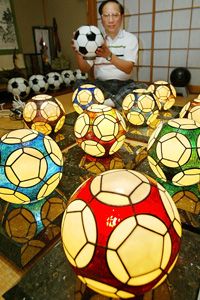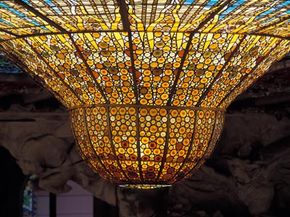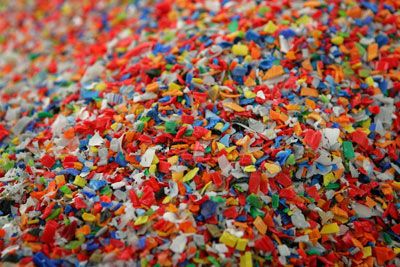Although glass itself is a naturally occurring substance and has color variations as a result of impurities, man-made glass was probably first created accidentally as a result of the high temperatures used in making pottery. To make glass, silica and other materials are melted and fused together. Silica (sand) melts at 3,000 degrees Fahrenheit (1,650 degrees Celsius) requiring the use of a glasshouse pot or kiln [source: Valldeperez]. The formulations, or recipes, for stained glass can vary from artist to artist but always include silica and substances like boric acid, lime, caustic soda and potash to strengthen, stabilize and help the stained glass ingredients melt uniformly at a lower temperature than silica alone.
Color is added to the melted silica using ground metal oxides. Once these coloring agents have been added to the molten glass, or gob, it's refired. The colored glass can then be manipulated in any number of different ways to achieve a specific result, like shaping or texturizing.
These manufacturing practices have changed over the last thousand years, been lost, rediscovered and refined. Although there are still closely kept secrets to the glassmaker's art that each artist protects, there are some basic methods of creating glass that we should take a look at:
Blown glass - Also called cylinder and antique glass, blown glass is made by using a blowpipe to create a glass cylinder that's then cut and annealed, or cooled, slowly. This is the old-fashioned way of manipulating glass and has been around for almost a thousand years [source: Valldeperez]. Because the thickness of the glass isn't uniform, the finished glass sheet has variations in color and small imperfections like the presence of bubbles. Blown glass is made in smaller batches than other glass-making processes and is one of the most popular types of colored glass.
Table glass - Known as cathedral glass and rolled glass, table glass is created by spreading molten glass onto a metallic working surface and then rolling it into a sheet.
Textured glass - Created by rolling, textured or pressed glass is made in a way similar to table glass, but a distinctive pattern or texture is worked into the glass as it cools. The result is less transparent but catches the light in unique ways.
Flashed glass - One of the historical disadvantages of vividly colored glass was that it tended to be opaque. Flashed glass was designed to solve this problem. Clear glass was coated with colored glass, originally red, and then cooled. The resulting glass was a sandwich made up of clear glass between two very thin layers of red glass. This veneer was colorful and highly transparent. The red could then be sanded or removed with acid to create different hues.
Molded glass - Glass can also be made using a mold to create shapes and distinctive concentrations of color. Rondels and art glass cabochons are created this way.
There are also a number of other types of artistic glass used in stained glass design. Opal glass and interpretive glass, like the style developed by Louis Comfort Tiffany in his famous decorative designs, are also popular for their unique appearance and refractive qualities.
Next, we'll take a look at the tools used in making stained glass.




